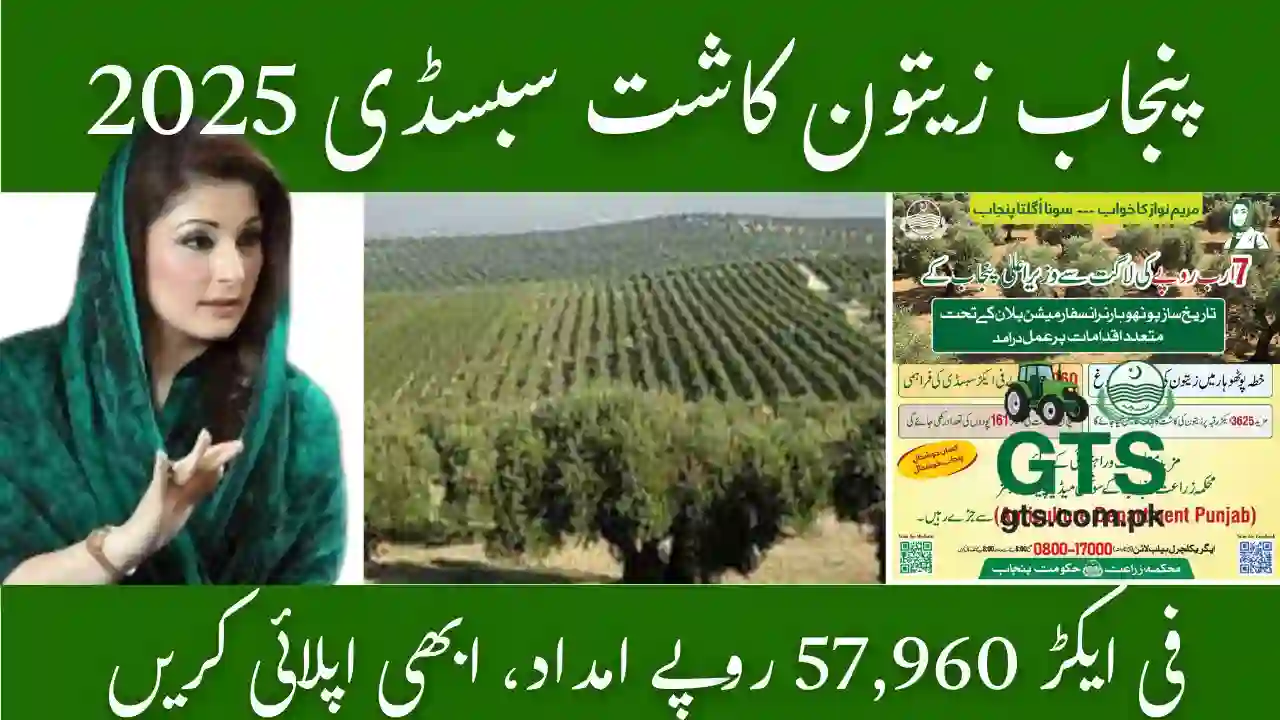Punjab Olive Farming Subsidy 2025 – Apply Now for Rs. 57,960 per Acre Support
Easily apply for the Punjab Olive Farming Subsidy 2025 and secure Rs. 57,960 per acre under the historic Potohar Transformation Plan. The Government of Punjab, led by Chief Minister Maryam Nawaz, has launched this visionary initiative to revolutionize agriculture and empower farmers through sustainable olive cultivation.
This project aims to make Punjab the “Olive Valley of Pakistan”, transforming barren lands into productive orchards while creating long-term income opportunities for local farmers. With government support, modern farming techniques, and training facilities, the dream of self-reliant agriculture is turning into reality.
🌳 Why Punjab is Promoting Olive Farming
Olives, known as the “golden fruit”, are globally valued for their use in edible oil, health supplements, and cosmetics. Pakistan imports a large volume of olive oil every year, costing billions in foreign exchange. By promoting domestic olive farming, the government is tackling two major goals — reducing imports and empowering rural farmers.
The Potohar region (including Chakwal, Attock, Rawalpindi, Jhelum, and Khushab) offers an ideal climate and soil for olive cultivation. Scientific studies have confirmed that this terrain supports high-quality olive yield with minimal risk.
By providing subsidies, guidance, and training, Punjab aims to make olive farming a profitable, long-term investment for rural communities.
Read More: Punjab Green Tractor Scheme Phase 3
🌾 The Golden Opportunity for Farmers
Unlike short-term crops that yield income once a year, olive trees provide consistent profit for decades. Once mature (after 3–4 years), a single tree keeps producing olives for up to 40–50 years. This means a farmer’s one-time effort can generate income for the next generation — a true “green inheritance.”
Experts now call this project the “Golden Crop Revolution of Punjab.”
🛢️ Future of Olive Oil in Pakistan
Pakistan currently spends billions importing olive oil. However, with the Punjab Olive Farming Subsidy 2025, this trend could reverse — turning the country from an importer into an olive oil exporter.
Local processing plants and packaging facilities are being planned in Potohar, creating new jobs and business opportunities across the value chain — from cultivation to export.
📊 Key Features of Punjab Olive Farming Subsidy 2025
💰 Subsidy Amount
- Farmers will receive Rs. 57,960 per acre in direct financial assistance.
- This helps reduce plantation costs and makes olive farming affordable for smallholders.
🌱 Cultivation Target
- The project targets 13,625 acres of new olive plantations across Punjab.
- This will turn underutilized land into productive olive orchards.
🌿 Plantation Density
- 161 olive plants per acre are recommended for ideal spacing and maximum yield.
🧑🌾 Farmer Support Package
- Financial assistance
- Free technical advice and soil testing
- Hands-on training on modern farming methods
- Active agriculture helplines (8 AM – 8 PM)
🧾 Step-by-Step Guide: How to Apply for Punjab Olive Farming Subsidy 2025
✅ Step 1: Check Eligibility
- Open to farmers in the Potohar region.
- You must own or lease cultivable land suitable for olive farming.
- Small and medium farmers are strongly encouraged to apply.
✅ Step 2: Prepare Your Land
- Get your soil tested (available at Agriculture Department offices).
- Land must be leveled and prepared with irrigation systems.
- Follow spacing guideline: 161 plants per acre.
✅ Step 3: Get the Application Form
- Visit your nearest Tehsil Agriculture Office.
- Request the Punjab Olive Farming Subsidy 2025 application form.
- Fill in your details:
- CNIC number
- Contact info
- Land size and location
- Ownership or lease documents
✅ Step 4: Submit Required Documents
Attach:
- Copy of CNIC
- Land ownership/lease papers
- Soil test report (if available)
✅ Step 5: Land Verification
Officials from the Agriculture Department will visit your farm to check land suitability.
✅ Step 6: Receive Subsidy and Support
Once verified:
- You’ll be registered for the subsidy program.
- Receive Rs. 57,960 per acre financial support.
- Get access to olive saplings and technical guidance from experts.
🌿 Benefits of Punjab Olive Farming Subsidy 2025
1️⃣ Financial Relief
Farmers receive direct financial aid, lowering startup costs and encouraging adoption of olive farming.
2️⃣ Long-Term Profitability
After 3–4 years, olive trees generate income for decades — ensuring financial security for future generations.
3️⃣ Health & Nutrition
Locally produced olive oil provides a healthy alternative and reduces dependency on imported oils.
4️⃣ Export Potential
Surplus production can be exported internationally, boosting foreign exchange earnings.
5️⃣ Eco-Friendly Agriculture
Olive plants improve soil health, prevent erosion, and adapt to climate-smart farming methods.
👩🌾 Farmer Training & Technical Guidance
Under the Maryam Nawaz Olive Farming 2025 initiative, the Agriculture Department offers free training on:
- Plantation methods
- Drip irrigation systems
- Pest and disease management
- Harvesting and storage techniques
- Olive oil extraction and marketing
Farmers can call the helpline 0800-17000 (8 AM to 8 PM) for expert guidance.
📈 Olive Farming by the Numbers – 2025 Targets
| Category | Details |
|---|---|
| Subsidy | Rs. 57,960 per acre |
| Plantation Density | 161 plants per acre |
| Coverage Area | 13,625 acres |
| Beneficiaries | Thousands of farmers |
| Vision | Make Potohar the “Olive Valley of Pakistan” |
⚠️ Challenges and Government Solutions
| Challenge | Solution |
|---|---|
| Low awareness among farmers | Awareness drives and field training |
| High initial investment | Government subsidy support |
| Long crop maturity period | Intercropping with short-term crops |
| Market access concerns | New olive oil processing plants planned |
🌿 Expert Tips for Successful Olive Farming
- Choose well-drained soil with good sunlight exposure.
- Maintain proper spacing between plants.
- Use drip irrigation to save water efficiently.
- Protect young plants from pests using organic methods.
- Apply natural fertilizers for stronger growth.
- Start pruning after the second year for better yield.
- Harvest carefully to maintain fruit quality.
❓ FAQs – Punjab Olive Farming Subsidy 2025
Q1. How much subsidy is provided?
Rs. 57,960 per acre is provided under the scheme.
Q2. How many olive plants per acre?
Each acre receives 161 plants.
Q3. Which areas are eligible?
Potohar region — Chakwal, Attock, Rawalpindi, Jhelum, Khushab.
Q4. Who can apply?
Any farmer with suitable land (owner or leaseholder).
Q5. How to apply?
Visit your nearest Agriculture Department Punjab or Tehsil Office and submit the application form with required documents.
Q6. Is olive farming profitable?
Yes. Olive trees bear fruit for decades with high market demand.
Q7. Are there training opportunities?
Yes, farmers get free training and helpline assistance (0800-17000).
🌾 Conclusion: The Green Revolution Begins in Potohar
The Punjab Olive Farming Subsidy 2025 marks a turning point in Pakistan’s agricultural history. With Rs. 57,960 per acre, technical support, and government commitment, farmers can now build sustainable livelihoods through olive cultivation.
This initiative is not just a subsidy — it’s a movement toward self-reliance, environmental sustainability, and rural prosperity.
Now is the perfect time to apply and become part of the Potohar Transformation Plan — the heart of Pakistan’s green future.







